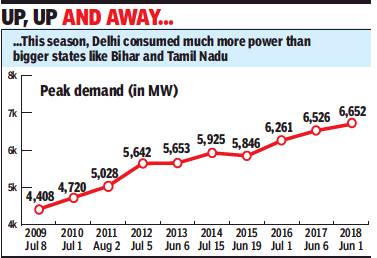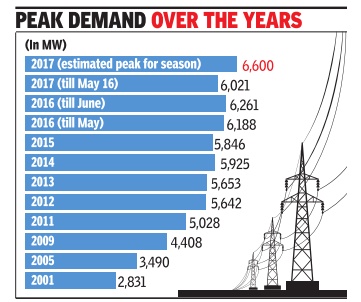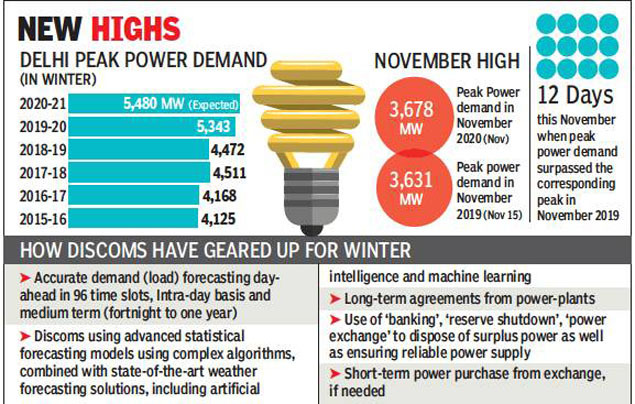Delhi: Power supply and consumption
(→Demand for power) |
(→2018, June) |
||
| Line 64: | Line 64: | ||
Peak power demand in BRPL’s areas in south and west Delhi, which had reached 2,745 MW in 2017, is expected to be around 2,882 MW this year. In east and central Delhi areas covered by BYPL, the peak power demand is likely to touch 1,668 MW against 1,469 MW last year. Discoms claimed that they had made adequate arrangements to source power to meet the peak demand of around 40 lakh consumers. | Peak power demand in BRPL’s areas in south and west Delhi, which had reached 2,745 MW in 2017, is expected to be around 2,882 MW this year. In east and central Delhi areas covered by BYPL, the peak power demand is likely to touch 1,668 MW against 1,469 MW last year. Discoms claimed that they had made adequate arrangements to source power to meet the peak demand of around 40 lakh consumers. | ||
| + | |||
| + | ==Winter peak power demand-== | ||
| + | ===2015-20=== | ||
| + | [https://timesofindia.indiatimes.com/city/delhi/colder-nov-power-demand-surges-past-last-years-peak/articleshow/79396989.cms Sidharatha Roy, November 25, 2020: ''The Times of India''] | ||
| + | |||
| + | [[File: Peak power demand in Delhi in November and in winter as a whole, 2015-20.jpg|Peak power demand in Delhi in November and in winter as a whole, 2015-20 <br/> From: [https://timesofindia.indiatimes.com/city/delhi/colder-nov-power-demand-surges-past-last-years-peak/articleshow/79396989.cms Sidharatha Roy, November 25, 2020: ''The Times of India'']|frame|500px]] | ||
| + | |||
| + | Colder November: Power demand in Delhi surges past last year’s peak | ||
| + | |||
| + | NEW DELHI: With the temperatures plummeting in the city, the seemingly early onset of winter this year is getting reflected in the power demand in the city. The peak power demand this November has already surpassed that of the same month last year prompting the discoms to gear up to meet a much higher demand this winter. | ||
| + | |||
| + | On November 20, the season’s peak power demand was 3,678MW compared with 3,631MW recorded on November 15 last year, according to sources. | ||
| + | |||
| + | But that’s not all. The peak power demand has surpassed the corresponding demand on 12 days till November 24 compared with the same month last year. The days when the peak power demand surpassed figures recorded in the same month in 2019 was on November 2 to 4, 9 to 13, 18, 20, 23 and 24. | ||
| + | |||
| + | The power distribution companies expect the city’s peak power demand to go up to 5,480MW this winter, surpassing last year’s demand during the season. Last winter, the demand had peaked at 5,343MW. | ||
| + | |||
| + | The peak power demand in Delhi during winter has been going up gradually. While it was 4,125MW in the winter of 2015-16, it increased to 4,168MW the next winter and to 4,511MW in 2017-18. However, it dipped to 4,472MW in the winter of 2018-19. | ||
| + | |||
| + | Earlier this month, the three discoms in the city, BSES Yamuna, BSES Rajdhani and Tata Power, had announced their winter action plan saying they were fully prepared to ensure adequate power during this season. | ||
| + | |||
| + | As part of the plan, BSES had said, “Ensuring reliable supply in any season is as much the function of proper electricity arrangements as also accurate demand forecast and robust distribution network.” It added that its supply arrangements during the winter months included long-term agreements with power plants, including hydro and Delhi-based gas fuelled generating stations, apart from more than 190MW of wind power, 70MW of solar power and 25MW from waste-to-energy. | ||
| + | |||
| + | Both BSES and Tata Power had said that they were using cutting edge technology to ensure 24x7 power supply, including advanced statistical forecasting models, combined with state-of-the-art weather forecasting solutions like artificial intelligence and machine learning. BSES had said that in case of shortage its discoms would buy short-term power from the exchange at affordable rates. | ||
| + | |||
| + | [[Category:Economy-Industry-Resources|P | ||
| + | DELHI: POWER SUPPLY AND CONSUMPTION]] | ||
| + | [[Category:India|P | ||
| + | DELHI: POWER SUPPLY AND CONSUMPTION]] | ||
| + | [[Category:Places|D | ||
| + | DELHI: POWER SUPPLY AND CONSUMPTION]] | ||
=High demand: causes= | =High demand: causes= | ||
Revision as of 07:02, 30 November 2020
This is a collection of articles archived for the excellence of their content. |
Contents |
Demand for power
2009-2018

From: June 2, 2018: The Times of India
See graphic:
2009-2018, June- The dates on which Delhi’s demand for power-electricity had peaked
2010- 2018, July

From: 7,000MW breached as city sweats, July 11, 2018: The Times of India
See graphic:
Peak demand of electricity in Delhi, June-August, 2010-18
2017
Paras Singh, As mercury rises, demand crosses 6,000 MW , May 17, 2017: The Times of India

Delhi's peak power demand crossed the 6000 MW mark, clocking 6021MW -highest in 2017. The number marks the season's highest power-demand so far. Discoms estimate this year's peak power demand may reach record 6600MW .
With mercury levels reaching record levels, the power demand has been record levels as well. In April, the demand touched 5685 MW -the highest ever power demand recorded in April. It was a whopping 18% more than the peak power demand recorded in April (4797 MW) last year. Si milarly , last month it was the first time ever that the peak power demand in the capital crossed the 4000 MW for March, an increase of over 14% from the peak power demand in the month for last year (3617 MW).
Delhi consumes the maximum power among the major cities of the country . Currently hovering around 6000MW , the capital's peak power demand is thrice as much as of Kolkata (around 2100 MW), 4 times that of Chennai (15001800MW) and as much as 60% higher than financial capital Mumbai (3700MW). The power appetite of Delhi is nearly two and a half times the power of seven North Eastern states draw together, which is around 2500 MW .
Higher power demands have been attributed to growing population, rising standard of living and exceptionally hot weather. Starting from 2MW in 1905, 27MW in 1947 to over 6000MW now, Delhi's electricity appetite has grown exponentially .
Power discoms Tata Power and BSES claim that ample arrangements have been made to source adequate power to meet the peak power demand of Delhiites this year. These arrangements include long term PPAs and banking arrangements with other states.
2018, June
Peak demand may cross 7,000 MW, June 2, 2018: The Times of India

From: Peak demand may cross 7,000 MW, June 2, 2018: The Times of India
See graphic:
Delhi’s peak demand for power- electricity, 2009-2018
Delhi is edging closer to an all-time high in peak power consumption. While the city’s power needs rise by an approximate 8-10% annually, the intense heatwave this year is likely to spike the peak demand by up to 20%. Delhi government is preparing for a summer peak of 7,000MW, but industry experts warn that even that may be crossed in the next two months.
Usually, Delhi sees its power demand peaking in June or July. Already, the number of times the demand has peaked in May this year is six times higher than the previous year. “The worst of the summer is yet to come. Over the next few weeks, the demand may surpass all previous records. Discoms will carefully monitor the situation to ensure there is no sudden gap in the demand-supply ratio,” an official said.
Delhi government has told discoms to be on a high alert and be prepared for any crisis. The government has already started the process of penalising power companies for unscheduled outages.
TOI had reported on Wednesday how the peak temperature in the capital had stayed at 43° Celsius or above for eight straight days — making it the longest spell of intense heat in the month of May in five years.
On Thursday, the power demand peaked at 6,417MW around 3:33pm, a tad lower than Wednesday’s peak demand of 6,442MW. In days to come, the demand is expected to rise even further. “We normally see the power demand peaking between 3pm and 4pm when air conditioners are working in full swing. Demand can also peak at night,” an industry expert said.
Discoms, meanwhile, are taking no chances. “As the Met department has predicted an extremely hot summer, we expect the peak power demand to reach 1,850MW in areas under our jurisdiction. The demand will be met through our longterm tie-ups and other suitable arrangements, amounting to around 2,200 MW. Our power-banking arrangements with other states will contribute significantly to ensuring regular supply and will take care of any contingency requirements,” Sanjay Banga, CEO, Tata Power-DDL, said.
Peak power demand in BRPL’s areas in south and west Delhi, which had reached 2,745 MW in 2017, is expected to be around 2,882 MW this year. In east and central Delhi areas covered by BYPL, the peak power demand is likely to touch 1,668 MW against 1,469 MW last year. Discoms claimed that they had made adequate arrangements to source power to meet the peak demand of around 40 lakh consumers.
Winter peak power demand-
2015-20
Sidharatha Roy, November 25, 2020: The Times of India

From: Sidharatha Roy, November 25, 2020: The Times of India
Colder November: Power demand in Delhi surges past last year’s peak
NEW DELHI: With the temperatures plummeting in the city, the seemingly early onset of winter this year is getting reflected in the power demand in the city. The peak power demand this November has already surpassed that of the same month last year prompting the discoms to gear up to meet a much higher demand this winter.
On November 20, the season’s peak power demand was 3,678MW compared with 3,631MW recorded on November 15 last year, according to sources.
But that’s not all. The peak power demand has surpassed the corresponding demand on 12 days till November 24 compared with the same month last year. The days when the peak power demand surpassed figures recorded in the same month in 2019 was on November 2 to 4, 9 to 13, 18, 20, 23 and 24.
The power distribution companies expect the city’s peak power demand to go up to 5,480MW this winter, surpassing last year’s demand during the season. Last winter, the demand had peaked at 5,343MW.
The peak power demand in Delhi during winter has been going up gradually. While it was 4,125MW in the winter of 2015-16, it increased to 4,168MW the next winter and to 4,511MW in 2017-18. However, it dipped to 4,472MW in the winter of 2018-19.
Earlier this month, the three discoms in the city, BSES Yamuna, BSES Rajdhani and Tata Power, had announced their winter action plan saying they were fully prepared to ensure adequate power during this season.
As part of the plan, BSES had said, “Ensuring reliable supply in any season is as much the function of proper electricity arrangements as also accurate demand forecast and robust distribution network.” It added that its supply arrangements during the winter months included long-term agreements with power plants, including hydro and Delhi-based gas fuelled generating stations, apart from more than 190MW of wind power, 70MW of solar power and 25MW from waste-to-energy.
Both BSES and Tata Power had said that they were using cutting edge technology to ensure 24x7 power supply, including advanced statistical forecasting models, combined with state-of-the-art weather forecasting solutions like artificial intelligence and machine learning. BSES had said that in case of shortage its discoms would buy short-term power from the exchange at affordable rates.
High demand: causes
2018: lowest tariff among big cities; inefficient ACs
How cheap power, inefficient ACs are pushing capital to the brink, June 13, 2018: The Times of India

2018: lowest tariff among big cities; inefficient ACs
From: How cheap power, inefficient ACs are pushing capital to the brink, June 13, 2018: The Times of India
Night Peaks Show Domestic Consumption Mostly Driving Up Demand
Cheaper electricity, combined with a lack of regulation to ensure efficient performance of air conditioners, is pushing up Delhi’s electricity demand to record levels.
A new analysis by the Centre for Science and Environment (CSE) released on Tuesday shows subsidised electricity and severe heat, combined with heavy use of air conditioners by the domestic sector, is fuelling this huge demand.
On June 8, 2018 Delhi’s peak demand hit an all-time high of 6,934 MW at 3.20pm, about 6.25% higher than last year’s 6,526 MW recorded on June 6, 2017. Electricity in the capital is cheaper than most other cities. Delhi Electricity Regulatory Commission (DERC) has slashed electricity rates for domestic consumers by 12-25% across all consumption slabs this year. Delhi government makes it even cheaper by providing a 66% subsidy on the rate for households that consume less than 400 units a month, and an additional rebate of Rs 100 on the fixed charge to households that consume less than 100 units a month.
The CSE analysis has found that the subsidised 400 units can easily accommodate use of one AC, lights, fans and other appliances. “If a 3-star split AC runs for six hours a day for 30 days in a month, it will consume about 260 kWh of electricity, which can be easily covered under the subsidised 400 units a month. Delhi government data shows that the subsidy was availed by 82% of homes last year — which means even higher income households are benefitting from the low rates, since there is no mandate for energy audits or compulsory disclosure of annual energy consumption,” says the analysis.
Even the highest slab with maximum rate in Delhi kicks in only if the monthly consumption crosses 1,200 units and is charged just Rs 7.75 per unit; in comparison, the maximum tariff in Mumbai is of Rs 9.95 per unit and is applicable on monthly consumption above 500 units. This is exacerbated by weak energy efficiency standards for air conditioners in India. For example, between 2013 and 2018, India produced more than 26.5 million AC units but more than 60% of those were 3-star rated as opposed to 5-star rated that is most
energy efficient. The International Energy Agency recently found that India has the worst market average measure of energy efficiency compared to major economies like US, Europe, Canada, China, Japan, Korea and Singapore.
CSE’s analysis also reflects that the residential sector has a major footprint on electricity demand. This is evident from the fact that peak demand is often highest at night compared to afternoon. During the month of May, for as many as 21 days, late night peak demand has been higher — up from 14 days in 2016. A typical summer day in Delhi has two peaks, one during the day (driven by commercial activities) and other around midnight (driven by residential sector). On an average, these two peaks have become almost identical now, says the analysis.
Electricity consumption in Delhi has increased by almost 42% between 2006-07 and 2017-18. On an average, electrified households in Delhi consumed about 260 kiloWatt-hour (kWh) of electricity monthly in 2016-17, similar to the electricity consumption of an average German household, the analysis added.
Power cuts
2017-18: lowest ever
Power cuts in 2017-18 lowest ever, govt data show, February 19, 2018: The Times of India
Delhi witnessed its lowest ever power cuts in the current financial year that also saw the highest ever peak power demand, according to a Delhi government data.
A government official said reduction in power cut points towards improvement in processes and systems of electricity supply and transmission.
“At 0.06%, Delhi witnessed lowest ever load shedding in 2017-18. This is almost six times lower than 0.4% witnessed in 2014-15,” the data stated.
Since 2014-15, the percentage of power cuts has been continuously dropping. From 0.4% in 2014-15 it dropped to 0.14% in 2015-16, 0.1% in 2016-17 and 0.06% in 2017-18, it stated.
Discom officials said this reduction in power cuts is noteworthy as the peak power demand has been rising over the years. Delhi’s peak power demand shot to 6526 MW on June 6, 2017, the highest ever.
The fact that the city’s electricity demand crossed the 6,500 MW reflects the robustness of power distribution and transmission system in the the national capital, they said.
BSES Rajdhani Power Ltd and BSES Yamuna Power Ltd together supply electricity to nearly two-third area of Delhi. Tata Power Delhi Distribution Limited supplies electricity to north and northwest Delhi. The discoms attributed the decrease in power cuts to coordination among various stakeholders, strengthened network capacity, use of latest technology and adequate power purchase agreements to meet the city’s electricity needs.